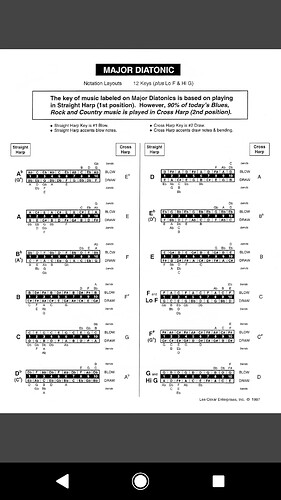@fallonsteve291 I have in various seasons practiced these quite a bit, and since reading your post here I’ve been practicing them a lot again! Thank you. 
In fact, you’ve inspired me to want to make some tabs videos on the subject for people to practice along with. (Haven’t made the vids, yet, but planning too.)
When practicing this stuff I only think of intervals, never note names. I think of note names when making sure I have the right harmonica, and then I NEVER think about note names when playing.
That probably comes from being a guitar player where we can just move a fret and use the same shapes/patterns to play in a new key, whereas @Slim is coming from playing flute where you HAVE to know note names.
I’ll occasionally think in intervals like you said in your post:
1,3,5,7
2,4,6,1
3,5,7,2
4,6,1,3
5,7,2,4
6,1,3,5
7,2,4,6
But more often, I think I’m playing the 7th chord arpeggio for:
I maj7
ii min7
iii min7
IV maj7
V7
vi min7
vii min7b5
But there’s a logical progression in approaching this kind of practice.
1st: Just 3rds. (in intervals 1,3 then 2,4 then 3,5, etc…)
2nd: Triadas (in intervals: 1,3,5, then 2,4,6, then 3,5,7, etc…)
3rd: 7th Chords
I also like to practice these kind of things in all 4 directions:
Ascending Intervals going up the scale (1,3, then 2,4, then 3,4…etc._)
Ascending Intervals going down the scale (coming from the top 6,1, then 5,7, then 4,6…)
Descending Intervals going up the scale (3,1 then 4,2, then 5,3, etc…)
Descending Intervals going down the scale (coming from the top 1,6, then 7,5, then 6,4…)
And then, (are we getting dizzy yet? lol  ) I like to practice them alternating up and down, so
) I like to practice them alternating up and down, so
1,3, then 4,2, then 3.5, then6,4, then 5,7, then 6,1 etc.
Most people practice ascending interval going up and descending interval go down, and I think that’s a great place to start.
I also think it makes sense as a natural progression to master 3rds before working on triads (since triads start with the 3rd) and mastering triads before working on 7th chords (since 7th chords start with the triad.)
There are interesting breathing patterns that emerge around the switch from the first 6 holes where draws are higher than blows to holes 7-10 where blows are higher than draws. All these kind of mirror images that are tricky at first, but then strangely become deeply satisfying (at least to me, lol) for some reason.
I’ll come back and post here when I make my first video on the subject.
Rock on! 

